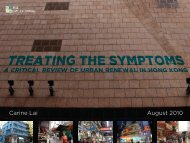Untitled - Civic Exchange
Untitled - Civic Exchange
Untitled - Civic Exchange
Create successful ePaper yourself
Turn your PDF publications into a flip-book with our unique Google optimized e-Paper software.
Chapter 1: A Sustainable Transport Policy<br />
• Growth in road transport - road traffic, construction of new infrastructure, and associated costs;<br />
• Growth in air transport - air traffic, aircraft noise, and emissions;<br />
• Congestion and associated costs;<br />
• Road casualties and associated costs;<br />
• Dependence on finite fossil fuel sources;<br />
• Vehicle emissions - air pollution and its global, regional, and local impacts and, to a lesser<br />
extent, water pollution;<br />
• Noise, vibration, visual intrusion, and other disturbance due to transport; and<br />
• Car-dependent planning and development (especially in developed economies) - inaccessibility<br />
to non-car users, high consumption of land, impact on community, social disruption, urban<br />
sprawl, decaying urban fabric.<br />
Challenges of multidisciplinary policy-making<br />
Progress towards sustainable transport depends on a wide variety of factors. It is often extremely difficult<br />
for policy-makers to understand the complexity of different policy options, such as how to set the optimal<br />
mix of incentives to change individual travel behavior or apply the right set of emissions control<br />
technologies. Developing and implementing an effective sustainable transport policy requires good data,<br />
continuous research, experimentation, and constant feedback from a diverse range of disciplines. The<br />
ability to develop a decision-making system that integrates knowledge and applies it on the ground is easier<br />
said than done.<br />
The attempt by the United Kingdom's Royal Commission on Environmental Pollution (RCEP) to articulate<br />
a new transport policy illustrates the complexities involved in implementing the concept of sustainable<br />
development. 20 The Eighteenth Report on Transport and the Environment stated that transport policies<br />
need to meet a set of wide-ranging objectives, including the integration of transport and land use policies,<br />
compliance with air quality standards, and mobility for all members of the community, and, at the same<br />
time, reduce environmental damage, use existing infrastructure efficiently, protect natural and cultural<br />
heritage areas, reduce the use of non-renewable resources, and reduce noise from transport. 21 Most<br />
governments lack experience in this type of multidisciplinary policy-making.<br />
However, when governments are able to put together an imaginative package of policy instruments with a<br />
realistic approach to long-term change this is far more effective than taking a piecemeal or ad hoc approach<br />
to sustainability. Thus, the best approach is to work backwards from the desired outcome of a policy and<br />
then develop long-term policy scenarios to explore how to achieve this outcome. This is often known as<br />
the scenario-building approach or the backcasting method. 22 Such an approach provides a useful<br />
framework for decision-making, identifies constraints and opportunities, allows a variety of possible<br />
approaches, helps with assessment of alternative policies, and increases creativity and choice. 23 9<br />
20 RCEP (1994), Transport and the Environment.<br />
21<br />
Ibid, xviii.<br />
22<br />
The OECD's environmentally sustainable transport approach started with a "portrayal of a sustainable transport<br />
future, the development of environmental and health quality objectives and criteria, and derived quantified targets<br />
with dates and milestones, and the specification and implementation of packages of measures required to achieve a<br />
sustainable transport future." The European Commission on Policy Scenarios for Sustainable Mobility also<br />
followed a similar methodology. OECD (2000), Environmentally Sustainable Transport Guidelines, p.7 and<br />
Banister, D., Stead, D., et al (2000), European Transport Policy and Sustainable Mobility.<br />
23 May, cited in Banister, D. and Stead, D. (2001), "Sustainable transport policies: scenarios for the future," in<br />
Giorgi, L. and Pohoryles, R.J., eds., Transport Policy and Research: What Future Aldershot: Ashgate, p.91.

















